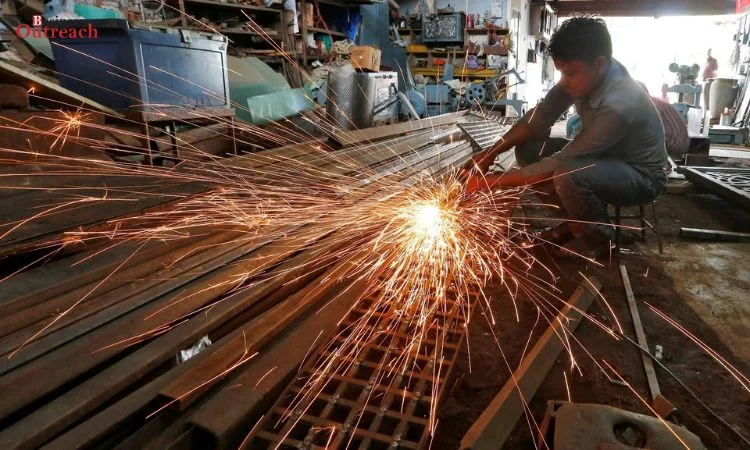India’s manufacturing sector, a vital part of the country’s economy, has experienced a slowdown in growth, reaching a three-month low. Despite this deceleration, the sector continues to perform above its long-term average, signaling resilience amid challenging conditions.

In January 2023, India’s Purchasing Managers’ Index (PMI) for manufacturing fell to 55.4 from 57.8 in December 2022. The PMI is a critical indicator of the economic health of the manufacturing sector, where a value above 50 suggests expansion, while below 50 indicates contraction. The dip to 55.4 marks a slowdown but remains comfortably above the threshold, indicating ongoing growth in the sector.
This three-month low PMI reflects several factors impacting the manufacturing landscape. Output and new orders, essential indicators of demand strength, showed slower growth compared to December, when the output reached a 13-month high. Foreign demand, an important component for manufacturing growth, also saw a reduced increase, reaching a ten-month low in new international orders. These trends suggest a cooling off in the rapid growth observed at the end of 2022.
Several elements contribute to the observed slowdown in manufacturing growth. One major factor is the rising input costs. Manufacturers have faced increased prices for key inputs such as chemicals, electronic components, energy, metals, and packaging materials. These rising costs have forced manufacturers to raise their selling prices, passing on the higher expenses to consumers. Despite this, the overall rate of inflation has moderated since December, indicating some easing of cost pressures.
Supply chain conditions, a critical aspect of manufacturing operations, have shown signs of improvement. Companies have been able to secure necessary inputs more efficiently, allowing them to rebuild inventories and support ongoing production. This improvement in supply chain dynamics has been a positive factor, helping manufacturers maintain output levels despite the cost pressures.
The manufacturing sector’s performance has significant implications for the broader Indian economy. Manufacturing is a substantial contributor to India’s GDP, employment, and exports. Therefore, the sector’s health directly impacts economic growth and stability. The recent slowdown, while notable, does not indicate a contraction but rather a moderation in the pace of growth.
The sector’s resilience is underscored by the continued rise in backlogs and the ongoing purchasing of additional inputs. These trends suggest that companies are preparing for sustained production in the coming months. However, the slower growth and elevated inflation may influence the Reserve Bank of India’s (RBI) monetary policy decisions.
The RBI has been navigating the dual challenges of controlling inflation and supporting economic growth. With the manufacturing sector showing signs of slower growth and persistent inflationary pressures, the central bank might consider a final interest rate hike. Such a move would aim to curb inflation while ensuring that economic growth remains on track.
The performance of the manufacturing sector should be viewed within the broader economic context. India, like many other countries, has faced numerous challenges in recent years, including the COVID-19 pandemic, global supply chain disruptions, and geopolitical tensions. These factors have collectively influenced economic activity, including manufacturing.
Despite these challenges, India has remained one of the fastest-growing major economies. The manufacturing sector’s ability to maintain growth above its long-term average, even during periods of slowdown, highlights its robustness. This resilience is crucial for India’s overall economic stability and growth prospects.
Industry experts and analysts have provided valuable insights into the current state and future outlook of India’s manufacturing sector. Pollyanna De Lima, Economics Associate Director at S&P Global Market Intelligence, noted that despite some loss of growth momentum, the sector is expected to remain in expansion mode. Rising backlogs and the purchasing of additional inputs indicate that companies are preparing for continued production increases.
However, there are areas of concern, particularly regarding exports. The latest PMI data revealed weakness in export orders, with only slight increases reported. This slowdown in foreign demand is a critical area to monitor, as exports are a significant driver of manufacturing growth.
The business expectations index, which measures optimism about the year ahead, also showed a decline to a six-month low. Employment generation in the sector remained just above the neutral mark, indicating limited job creation. These indicators reflect the cautious sentiment prevailing within the industry.
Looking ahead, the manufacturing sector’s future prospects will depend on several factors. Continued improvement in supply chain conditions and stabilization of input costs will be vital for sustaining growth. Additionally, the sector’s ability to adapt to changing global demand patterns and maintain competitiveness in international markets will be crucial.
Government policies and initiatives aimed at supporting manufacturing, such as the “Make in India” campaign, will also play a significant role. These policies aim to boost domestic production, attract foreign investment, and enhance the sector’s global competitiveness.
In conclusion, while India’s manufacturing sector has experienced a slowdown in growth, it remains robust and continues to perform above its long-term average. The sector’s resilience amid rising input costs and global economic challenges underscores its importance to the Indian economy. With careful policy management and continued industry adaptation, the manufacturing sector is well-positioned to navigate future challenges and contribute to sustained economic growth.















